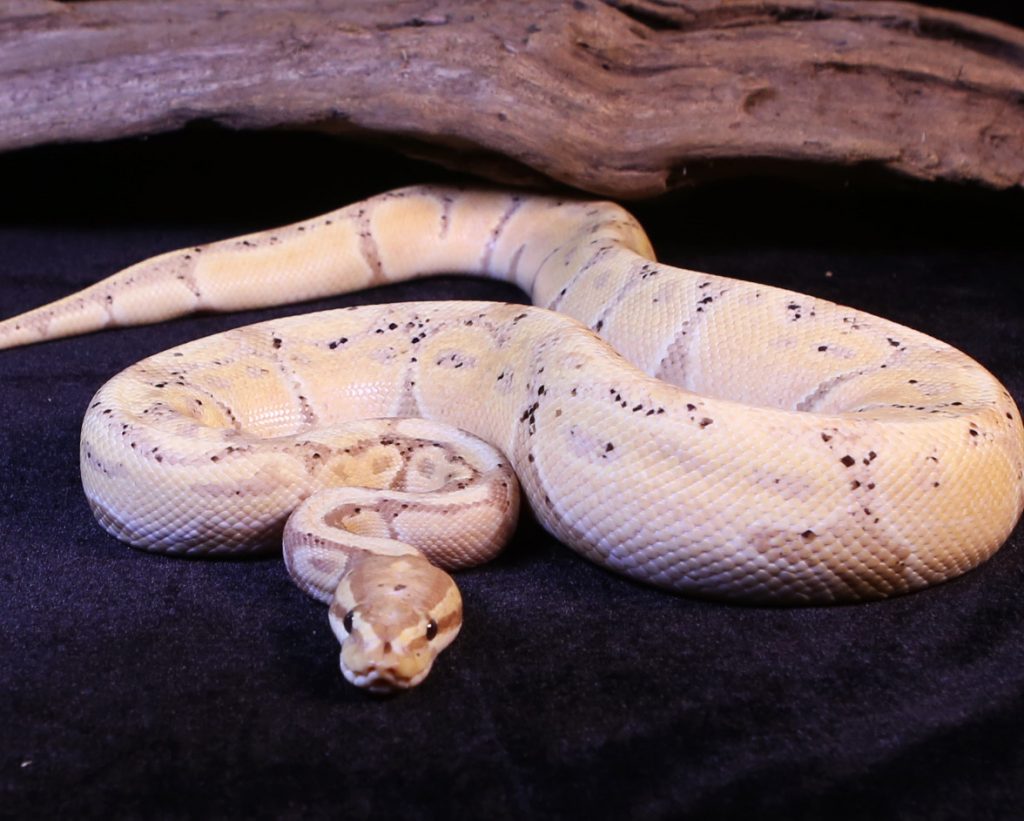The ball python, Python regius, is the most commonly-kept python in the world, popular with both first-time keepers and experienced herpetoculturists in the US, Europe, and even the Philippines. Although usually shy, ball pythons make ideal pets because they are small, generally friendly, easy to take care of, and are available in a dazzling variety of colors and patterns.
Did you know?
Python regius is also known as the Royal Python in Europe, but it is native to central and western Africa where it is revered, and it thrives in warm, tropical environments.
Ball python hatchlings are about 10 inches in length. Adult females average 3-5 feet long, while adult males are smaller, at around 2-3 feet. Ball pythons that are 5 feet or longer are considered quite big, and pythons of 6 feet or more have been reported. With proper care, ball pythons can live for 30 years or more.

How to care for a ball python
1. Feed with a rodent no bigger than the ball pythons largest circumference
Ball pythons can eat rats from a young age, starting with rat pups and moving up in size as they grow. Don’t handle your snake for at least a day after feeding, as this can lead to regurgitation. Adult ball pythons eat every 1 to 2 weeks, while younger ball pythons need to feed weekly because they need the energy to grow.
2. Always have fresh water available
Check the dish daily. Snakes will defecate in the water bowls from time to time, so clean and disinfect them on a weekly basis.
3. Use plastic boxes or full of glass reptile terrariums as enclosures
Just keep in mind that the more you put in your snake enclosure, the more you will have to clean and disinfect on a regular basis. When using a terrarium or tank, remember that the screen tops of such enclosures may cause challenges in keeping the proper humidity levels.

4. Remove feces and urine as soon as possible
Spot clean your ball python’s enclosure whenever necessary. Remove all substrate and reptile accessories every 30 days and completely disinfect them with a 5% bleach solution.
Rinse the enclosure with water and dry it completely before returning the cage accessories and your ball python.
5. Look for captive-born and bred snakes
Wild-caught ball pythons are difficult to feed and may carry ticks. The prey of wild ball pythons are gerbils, which may be expensive to purchase regularly. Wild ball pythons will sometimes refuse to eat mice, even when starving.
In contrast, captive-born and bred ball pythons are docile and easy to take care of. They have a high tolerance for being handled, and unlike the wild-caught ball python, which usually comes in only one morph – the normal type – captive-born and bred pythons come in a wide variety of morph due to their potential for selective breeding.
6. Always provide your ball python with a hide box
Ball pythons are shy and secretive, and they appreciate and make good use of hide spots.
Place a hide box on each end of your snake’s enclosure so that it can choose whichever spot has the desired temperature. Clay flowerpot, plastic flowerpot trays, and commercially-available hide boxes all work well.
7. Provide a proper thermal gradient for your snake
It should have a hot spot at one end of the enclosure at about 88 to 96 degrees F and a cool spot of 78 to 80 degrees F on the other. Use a thermometer and make sure that the ambient temperature does not fall below 75 degrees F.
Undercage heating pads and tapes and basking bulbs are a few types of snake heat lamps that can help your ball python stay warm. Keep an eye on the humidity within the enclosure, especially if it has a screen top, as heat can quickly dry the air.
8. Choose the right substrate
Newspapers and paper towels are the cheapest and easiest substrate, while mulch and bark can help control the enclosure’s humidity.
Avoid collecting substrate from the wild as they may contain parasites and other organisms that are harmful to your ball python. Do not use cedar shavings because the volatile oils in the shavings can cause skin, respiratory, and reproductive damage to your snake.

9. Support their body during handling
Avoid fast movements. When a ball python realizes you will not hurt them, they will learn who you are and will even seem to enjoy being handled.
Relax during handling and give it time to settle. The goal is to establish trust between you and the python.
This appeared in Animal Scene magazine’s August 2019 issue.
Photos by Jeffrey C. Lim
Related stories:
– Coiled in the banana pewter bee ball python
– Ball python: More on the morph
– First in the world: The GHI Lesser Cinnamon Pinstripe ball python morph






